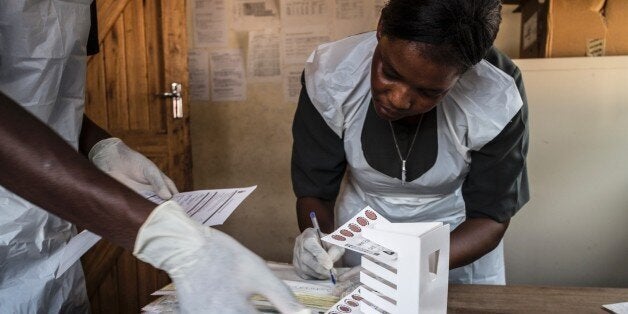
When the United Nations convenes this week for its High Level Meeting on HIV/AIDS, the corridors will be buzzing with talk of "the end of AIDS." UNAIDS tells us that it will happen provided key testing and treatment targets, including doubling the number of people on antiretroviral treatment, are achieved within four years. UNAIDS and major funders have determined that a "fast-track" strategy -- focusing on a subset of countries with highest transmission -- is the best way to reach these goals. While a renewed ambition to quickly curtail one of the deadliest pandemics in history is laudable, the global health community risks significant treatment gaps and continued HIV transmission if the focus is only on highest transmission countries.
The global health community simply cannot afford to ignore the HIV epidemic in Western and Central Africa (WCA), where five million, or a third, of the 15 million people who should be started on antiretrovirals in the next four years currently live. WCA countries account for one in five new HIV infections worldwide and a third of the 1.2 million AIDS-related deaths a year. The reason: only one in four people who need antiretroviral treatment have access to it.
The strategy to end AIDS should aim to roll out antiretrovirals to all, particularly where treatment gaps are the largest. However, UNAIDS, PEPFAR, the Global Fund and others aim to instead sharpen their focus on so-called "hot spots," high prevalence areas or most-at-risk groups. The alignment of these strategies may lead to rationing of lifesaving interventions, meaning that the global goals cannot be achieved because it leaves the virus' deadly spree unchecked, outdoing progress elsewhere. Populations wrongly perceived to be of marginal interest for epidemic control cannot once again be left behind. We know that treatment saves live AND prevents new infections, and that expanded access to ARVs is the best way to bring the epidemic under control. This is most dramatically illustrated by a chilling statistic from this region: each year 45 percent of all infants infected around birth are from WCA. These new infections are almost completely preventable when mothers have access to antiretrovirals during pregnancy and soon after birth.
Despite these glaring needs, WCA remains out of focus internationally, mostly because of its relatively low average prevalence of 2.3 percent (still three times the global average), and dearth of alternative actors that can provide the full package of HIV prevention and treatment interventions. Countries with lower prevalence or smaller populations do not score high on the priority list and, as a result, suffer disproportionately from HIV/AIDS. In 2004, when antiretroviral started to become accessible in the most affected regions in the South and East of Africa, 25 percent of HIV-related deaths were occurring in West and Central Africa. Twelve years later, as the ART programs in high prevalence countries have dramatically expanded, mortality there has dropped. Not so in WCA, which now accounts for 36 percent of all HIV-related deaths on the continent. It is difficult to foresee a reversal of this trend without strong action taken in these regions left behind.
Doctors Without Borders witnesses daily the human toll of the continued neglect of people living with HIV in the region. In our specialized AIDS hospital in Kinshasa, patients are admitted in advanced stages of AIDS that have become relatively rare since the mid-2000s even in the most affected countries. One in four of our Kinshasa patients are so severely ill from AIDS that they cannot be saved. In the Central African Republic, where HIV/AIDS is the leading cause of death amongst adults, MSF-supported hospitals see very high number of AIDS patients, a situation reminiscent of the nineties in other countries. In these hospitals one in four in-patients suffer from AIDS-related illnesses and over four in five of all deaths are due to HIV/AIDS.
Let's be frank: the challenge of scaling up antiretroviral treatment in WCA is huge. But the challenge was no less huge 16 years ago, when the world decided to mobilize to make access to ARVs a reality for all. Through the creation of PEPFAR and the Global Fund a chance at life on ART was created for people living with HIV in countries most affected by AIDS. This decision broke the deadly circle of HIV deaths and suffering and brought most high prevalence countries closer to the "tipping point" for epidemic control, where the number of people initiated on antiretroviral surpassed the number of new infections. This point is still far off in WCA. Leaving things at the current status quo would be a strategic mistake. The stated goal of curtailing the pandemic worldwide would fail.
What allowed success in many of the most affected countries was the embrace of major changes in strategies and models of care, such as task shifting, strict no-payment policies for patients, patient literacy and autonomy, de-medicalized and community based ARV refills and a key role for patient associations and civil society organizations in stigma reduction, service delivery, advocacy and outcome monitoring. Unfortunately, many of the lessons learned remain largely unapplied in WCA today, with some pilot experiences in the region as positive but lonely exceptions.
For this reason, MSF is calling for an ambitious catch-up plan for countries with low antiretroviral coverage such as most of those in West and Central Africa. People's right to lifesaving ARVs should not be curtailed based on who they are, where they live or the specific characteristics of the HIV epidemic they face. If the world is serious in its goal of defeating AIDS, it is time to bring in the cavalry with the necessary resources to seriously tackle HIV and bring lifesaving ARV to some of its weakest and most neglected victims. This will not be possible without the commitment of powerful international donors and organizations. The people left behind by the HIV revolution over the past decade should not be forgotten once again. The crucial next four years may be their last chance to benefit from what the world has learned from the successful mobilization against HIV. We should, and can, care for the most vulnerable, for their sake and for the sake of curbing the epidemic.
